Many businesses turn to LinkedIn—the world’s largest professional network—to tap into the right audiences to grow their operation.
In this guide, we’ll explain the reasons why you should use LinkedIn for lead generation. We’ll also provide tips for connecting and engaging with your ideal audience on the platform. Finally, we’ll show you how to monitor your LinkedIn performance to measure customer growth.
Why Use LinkedIn for Lead Generation?
LinkedIn stats show it’s the number-one platform for business-to-business (B2B) lead generation.
These are a few reasons why you should use the social platform to source qualified leads for your brand:
Professional Networking
Designed for engaging and building relationships with other professionals, the LinkedIn space helps you connect with potential customers in relevant industries. And nurture relationships that can lead to business opportunities.
Credibility and Trust
Having a social presence on LinkedIn can establish your brand as a credible and trustworthy player in your industry or niche. Making it easier to turn connections and followers into leads.
Content Marketing
LinkedIn lets you create and share valuable content with your audience. Showcasing content related to your expertise can attract leads who may be interested in your offerings. Establishing your brand as an authority or thought leader in the process.
Targeted Advertising
LinkedIn offers advertising options you can take advantage of to target specific industries, job titles, interests, and more.
The targeting options available can help you reach the right potential buyers for your products or services.
7 Best Practices for LinkedIn Lead Generation
Here are seven recommended best practices to kickstart your LinkedIn lead generation strategy and marketing efforts.
1. Optimize Your Profile and Business Page
A LinkedIn profile is like an online resume and professional showcase, while a business page serves as a billboard for your business offerings and activities.
Optimize your own, coworkers’, or employees’ profiles and your brand’s business page to make a positive impression on people viewing them. And attract potential leads searching for topics related to your products or services.
Here’s how.
Use a Professional Profile Photo and Compelling Cover Image
Choose high-quality headshots that align with your brand personality. Presenting individuals that work there as approachable and professional. Also, use a compelling cover image that conveys what you offer your audience.
Here’s an example of profile elements that give a positive first impression:
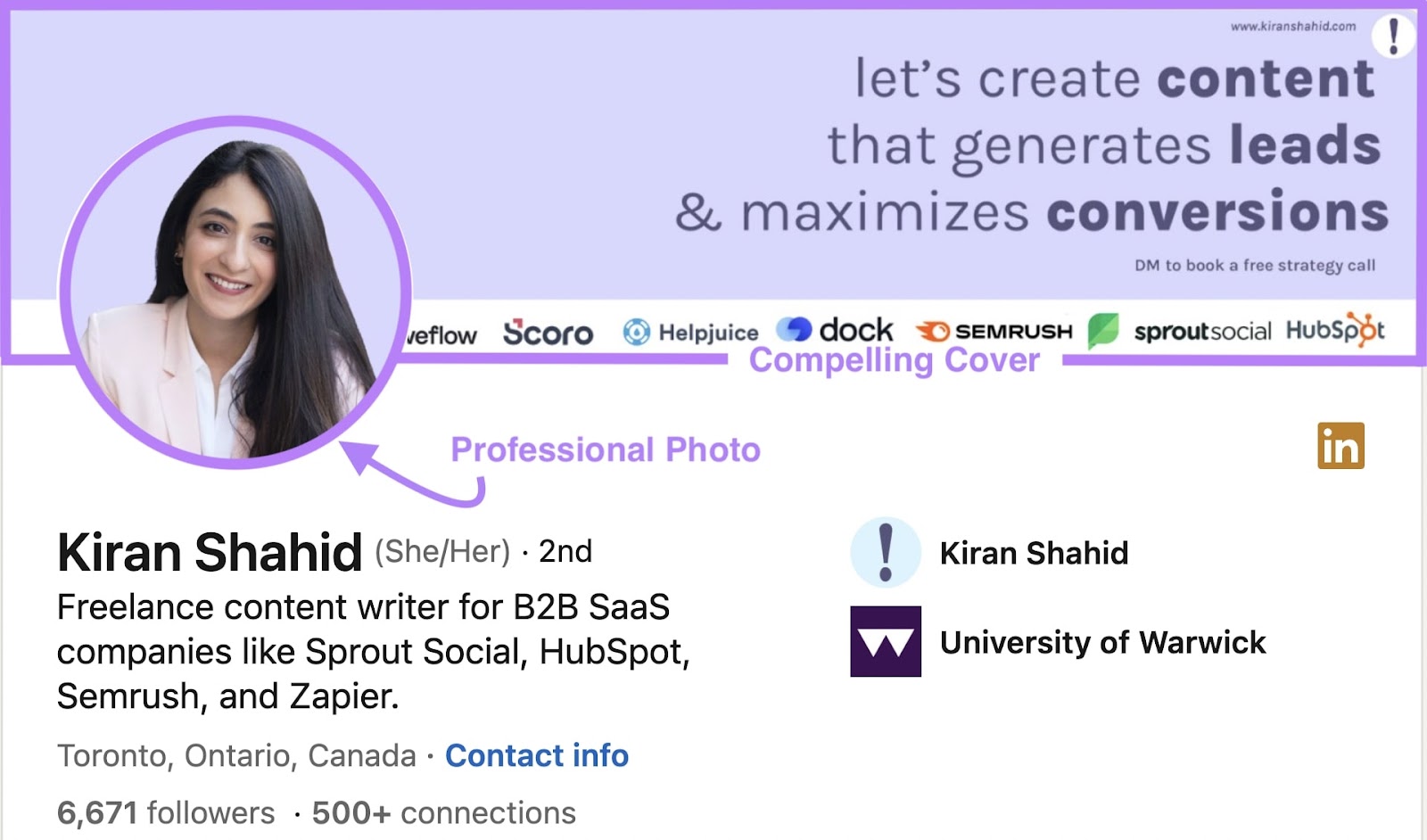
Write a Descriptive Headline
The headline is one of the first things people see on your LinkedIn profile. It also appears next to your name in the main feed when you publish posts.
Clearly show what you do by including your role or job title and your unique selling proposition (USP).
In this example, the headline includes a job title, a secondary role, and a USP:
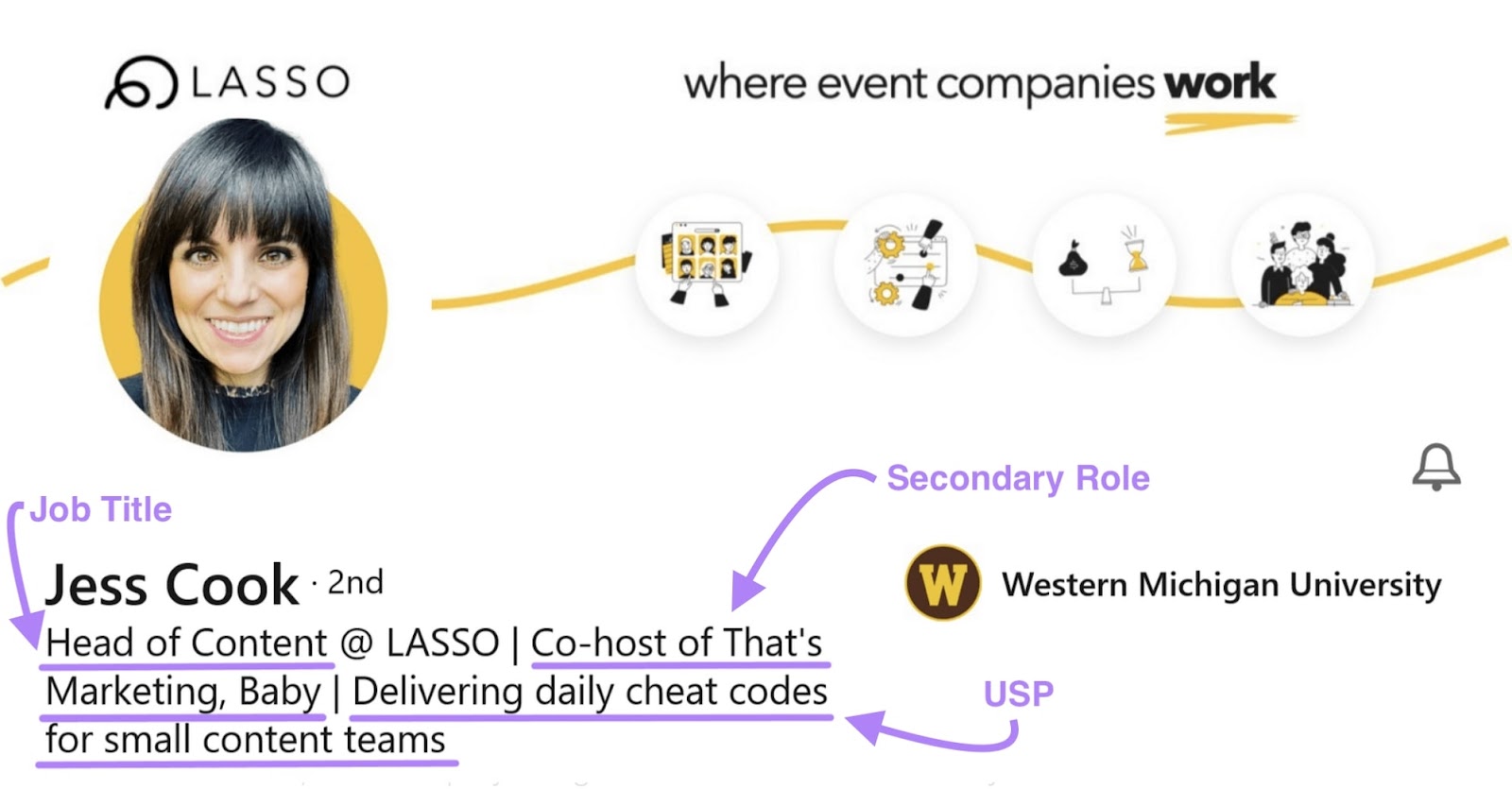
Write a Compelling “About” Section
The “About” section of your personal LinkedIn profile is where you can craft a compelling summary. Showcase your skills, what you do for customers, and what sets you apart from competitors.
Include a call to action (CTA). For instance, direct people to contact you, visit your website, or download a resource. The right message can convert profile views into leads.
In this example, the founder of content marketing brand Haus of Bold speaks to the target audience’s main goals. And explains what the business solves for “a specific type of company.” Then lists notable clients in her portfolio.
The section ends with two CTAs.
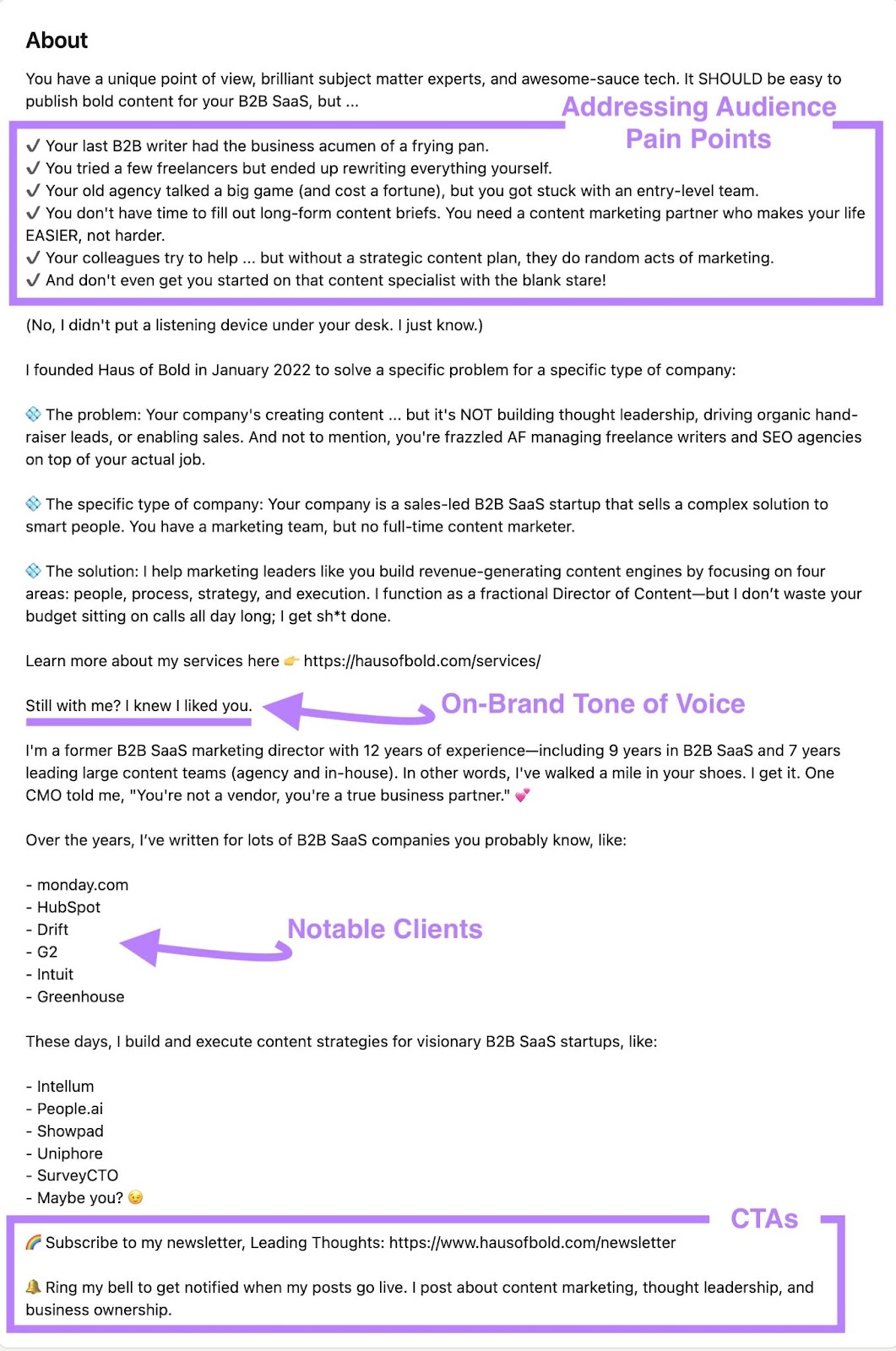
Fill Out Your Profile Completely
Take advantage of everything your LinkedIn profile has to offer by filling out all fields. For instance:
- List relevant work experience and highlight key achievements to establish your credibility and expertise
- Add your skills and ask your connections to endorse them. Which helps validate your expertise and makes your profile more attractive.
- Request recommendations from clients or other professionals. Positive feedback can build trust with potential customers.
Use Relevant Keywords
As you set up your profile, include keywords relevant to your business that your ideal audience searches for. Which is helpful for LinkedIn SEO.
Research the right keywords in Keyword Magic Tool. You’ll find it under “SEO” > “Keyword Research” in the Semrush dashboard menu.
Let’s say you’re a tax preparer who wants to appear in searches for tax preparation keywords.
Go to the tool and enter “tax preparation” into the search bar. Choose the country you want to target and click “Search.”

You’ll see a list of keyword ideas allowing you various ways to filter the results.
Since you’re looking to attract leads, narrow the list down to the most relevant keywords. Select “Commercial” and “Transactional” from the “Intent” drop-down. Click “Apply.”
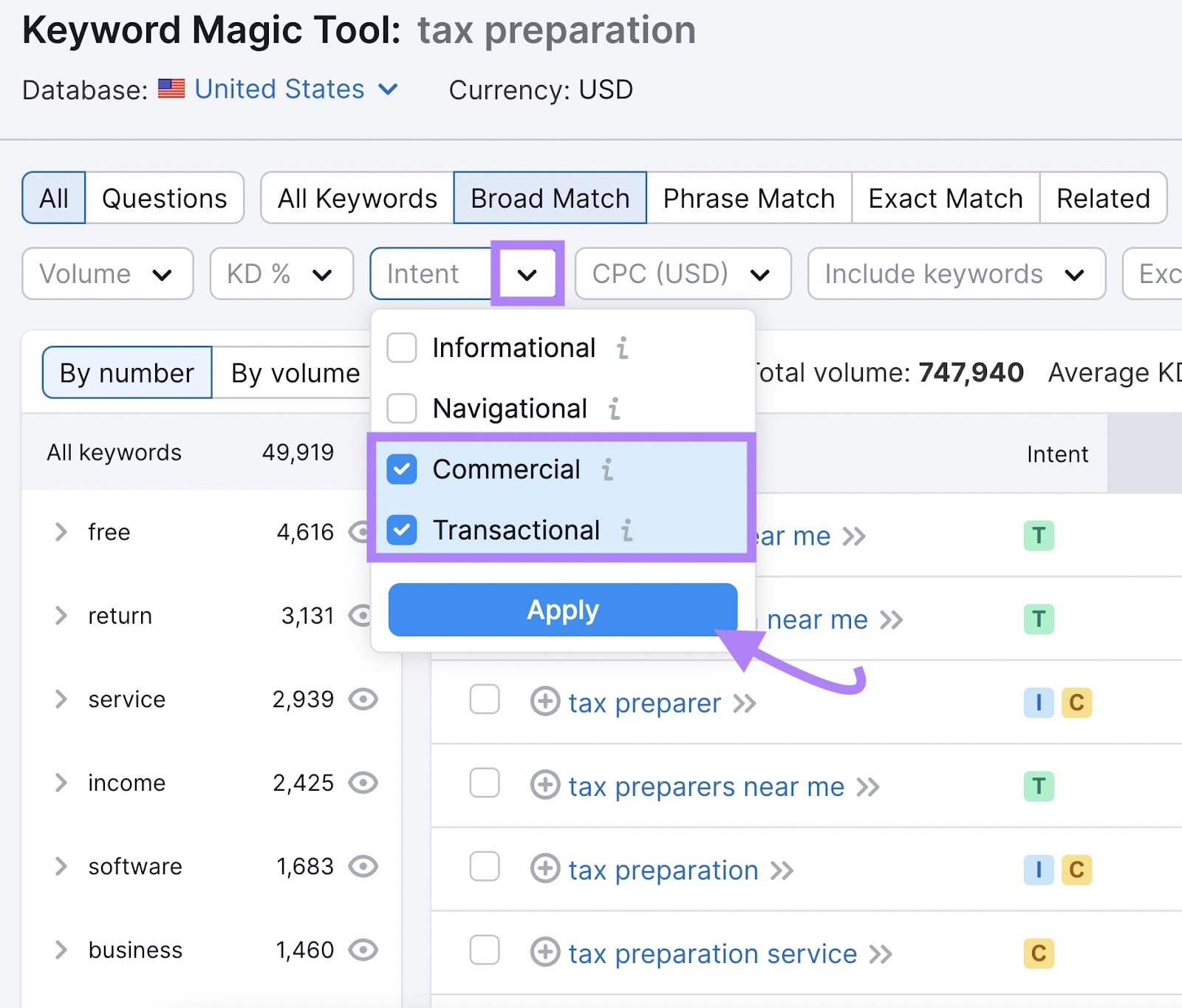
Now, the list displays keyword ideas strictly with commercial or transactional intent.
The tool also organizes the ideas by category.
Filtering for “service” keywords is a good place to start. You might also consider other categories like “business” or “professional.”
If you click “service” in the left-hand category pane, the list will show all service-specific terms.
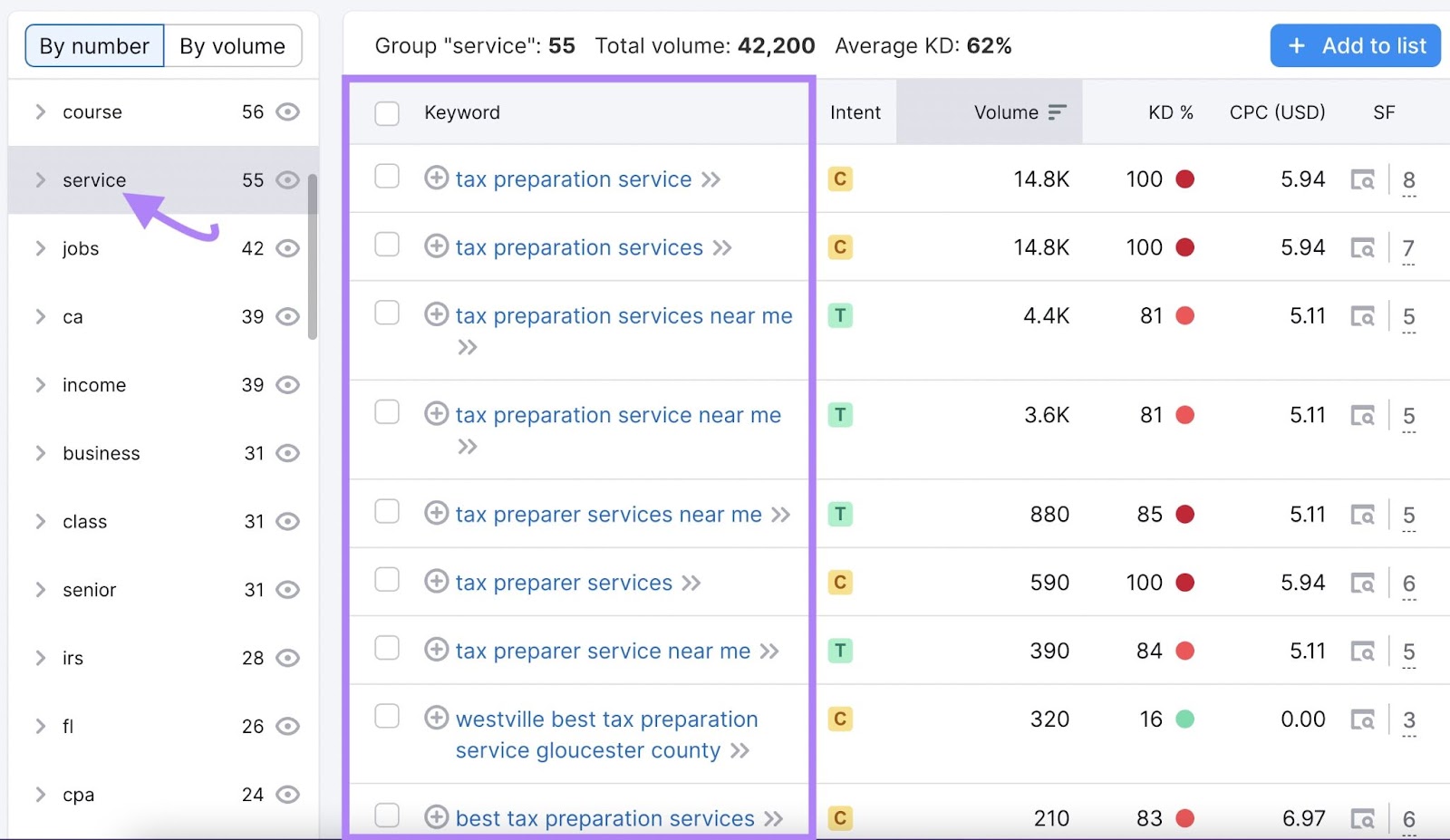
Note down the keywords that make sense for your business. When you’ve settled on a handful of target keywords, naturally incorporate them throughout your LinkedIn profile.
Here are some key places to include keywords on LinkedIn:
- Headline
- “About” section
- Experience
- Skills
Set Up Your Optimized Business Page
In addition to your personal profile, create a free LinkedIn business page to represent your brand on the platform.
A business page has similar aspects to a LinkedIn profile, such as the headline, industry field, and “About” section. It also features elements that differ – like the “Products,” “Jobs,” and “Events” areas.
Here’s Semrush’s business page as an example:
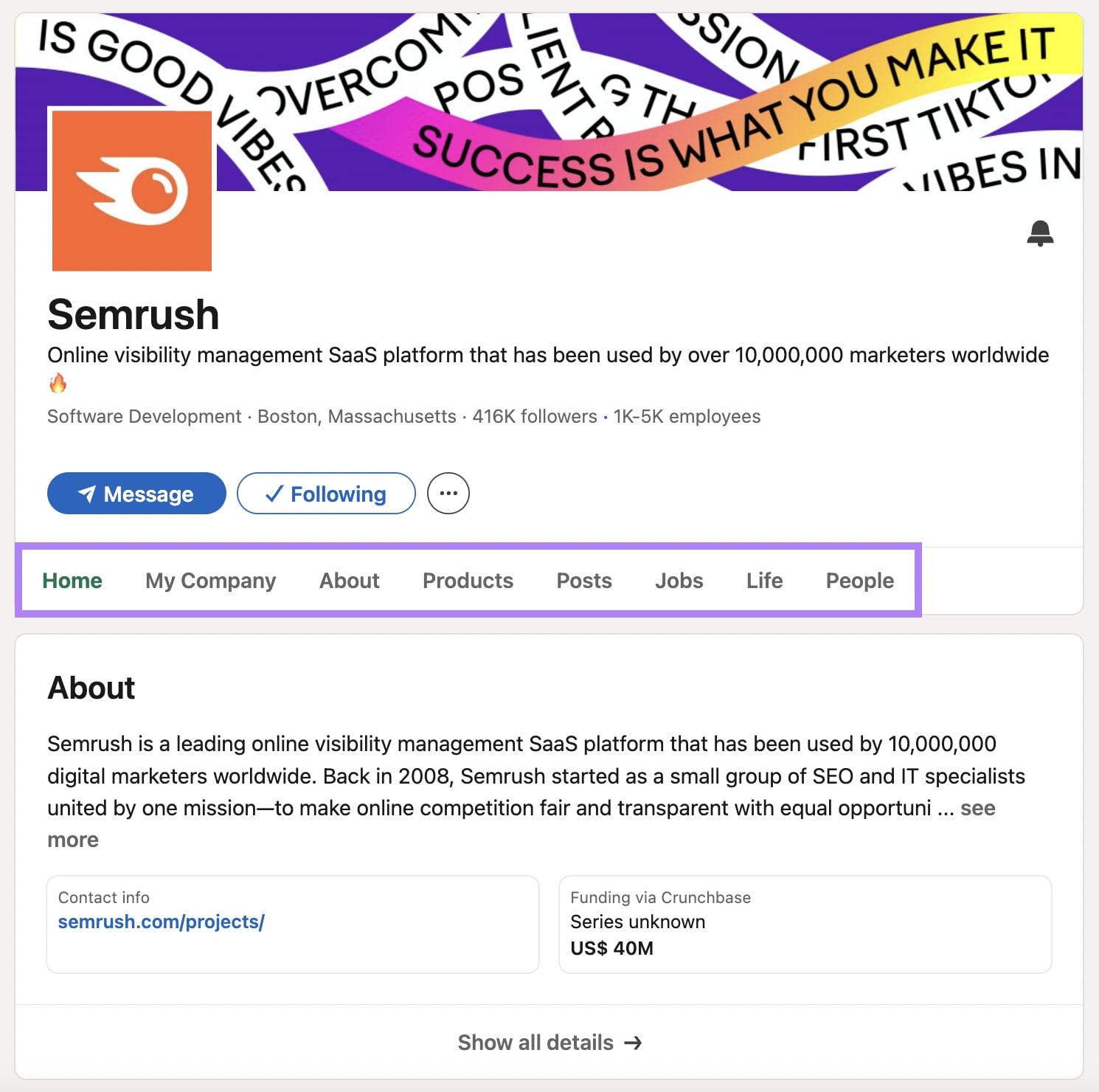
You can generally optimize your LinkedIn business page with the same keywords you used on your profile. And fill out as many page elements as you can to provide helpful information to your followers and potential leads.
2. Add a Custom Button to Link to Your Site
Use LinkedIn’s custom button feature on your profile to direct people to your brand’s offering and generate leads. You might choose to link to a product or service page, a free trial, a portfolio, or other relevant content on your site.
Here’s an example of a finance writer using this feature to link to their writing services:
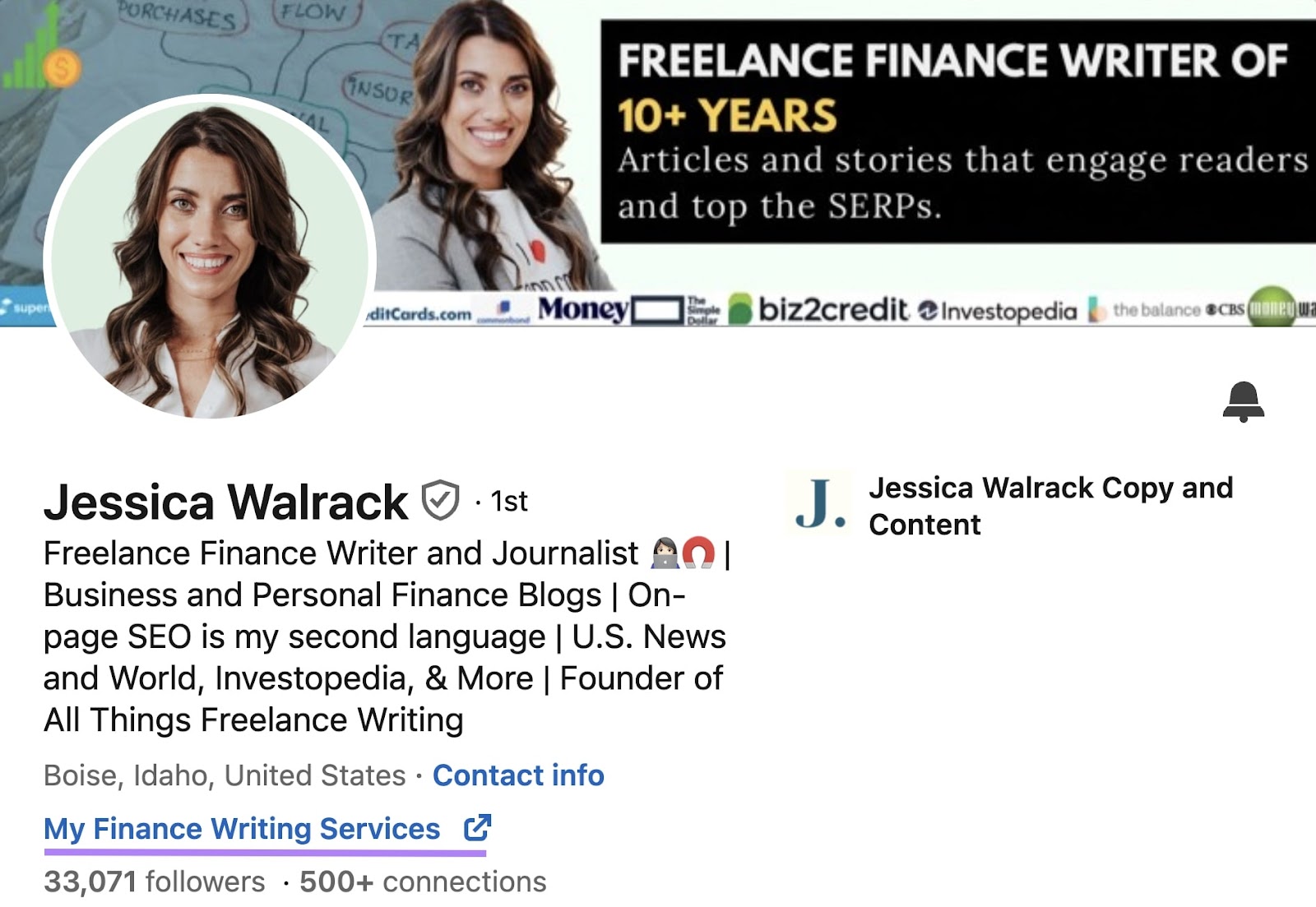
3. Connect with Potential Customers
Identify Your Target Audience
Finding your target audience is the most important step. Otherwise, you’ll waste time reaching out to the wrong people.
Think about who your target customer is. Consider what industry they’re in, their job title, where they’re located, and so on.
For example, to reach small businesses for your tax prep service you’ll likely want to connect with owners, founders, and CEOs. Small businesses may not have a finance professional on staff.
Start Searching
The search for leads can be time-consuming, and you might consider a LinkedIn lead generation service to handle it. But the LinkedIn site’s search functionality lets you look for the exact type of leads you want.
Use multiple filters like these to browse profiles:
- Connections (first, second, and third degree)
- Connections of a person
- Current company
- Followers of a person
- Industry
- Keywords (first name, last name, title, company, school)
- Location
- Past company
- Profile language
- School
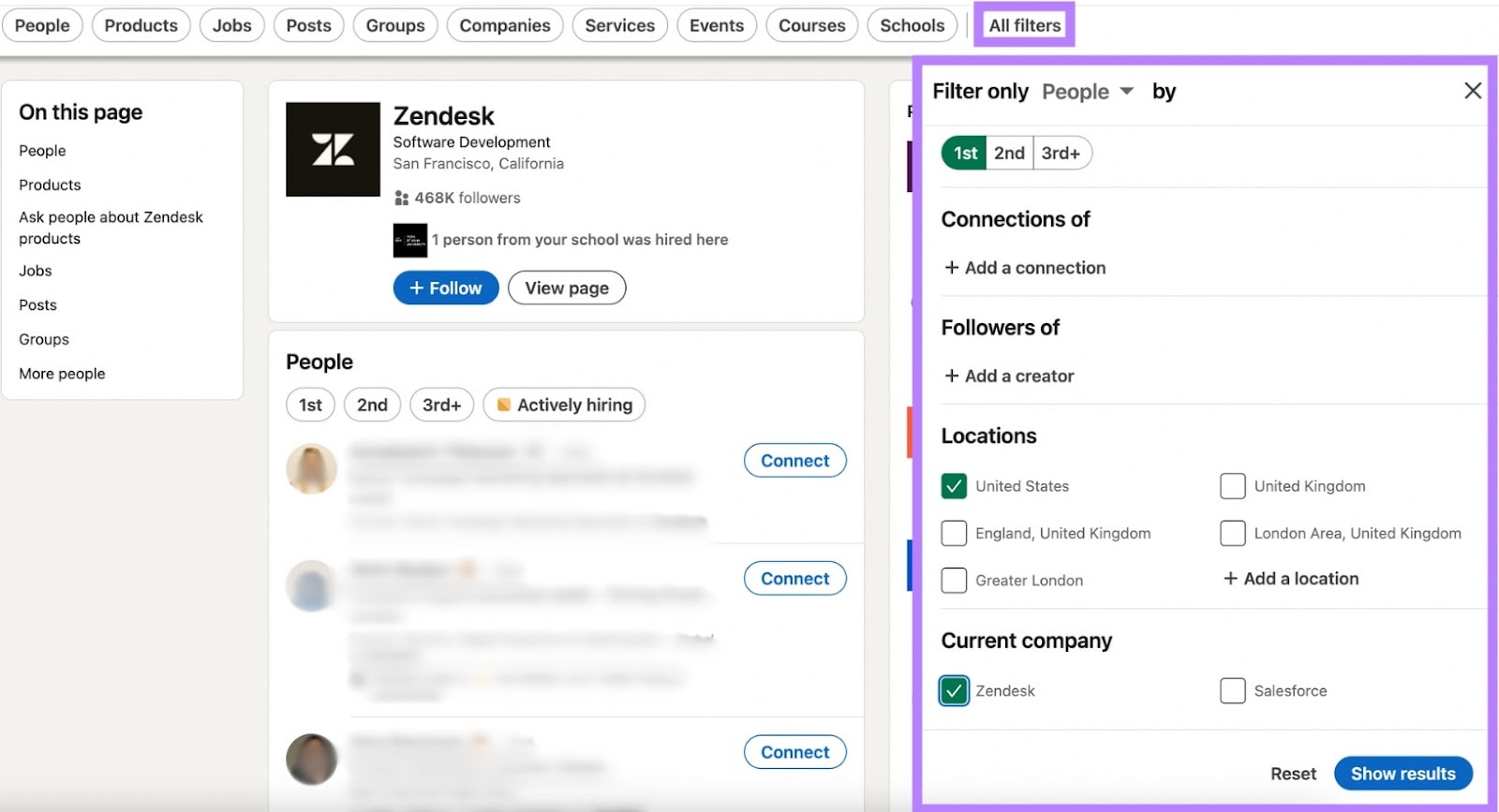
Personalize Your Connection Requests
When you come across a potential lead, send them a connection request with a relevant and engaging personalized message. You can include a note of up to 200 characters.
Don’t pitch just yet. The goal here is to start a professional relationship and ease into a conversation to learn about each other. Mention why you want to connect and how you provide value to them.
Follow Up
When someone accepts your connection, respond with a personalized message to say thanks. Or ask them about projects they’re working on—or what their goals are for this year.
Continuing the conversation helps you build a relationship with your prospect while keeping your name and business top-of-mind.
4. Post Regularly
Post consistently on LinkedIn via both your personal profile and business page to remain visible in your network. And establish yourself as an active professional and brand in your industry.
Aim for a couple of posts per week. Regular, relevant content demonstrates your expertise and commitment to staying informed. Diversify your posts to see what gets the best engagement and turns connections into leads.
As a tax preparer, you might post about the following from your personal profile:
- Tips: Quick tax-saving tips
- Seasonal content: Share reminders, deadlines, and last-minute tips during tax season
- FAQs: Answer common tax-related questions
- Collaborations: Tag other professionals related to your industry (such as financial advisors or attorneys) to foster partnerships
From your business page, you might share things like:
- Industry news: Tax law changes, IRS updates, etc.
- Client success stories: How you helped a client save money or navigate a complex tax situation
- Company updates: Recent company news, events, and employee recognition
Consider a content calendar to keep up your posting routine. Semrush’s Social Poster is an ideal tool for creating and scheduling your LinkedIn posts.
First, set up a project in the Social Media toolkit. Enter your website and click the “+ Create project” button.

Give your project a name and click “Create project.” You can use the name of your business.
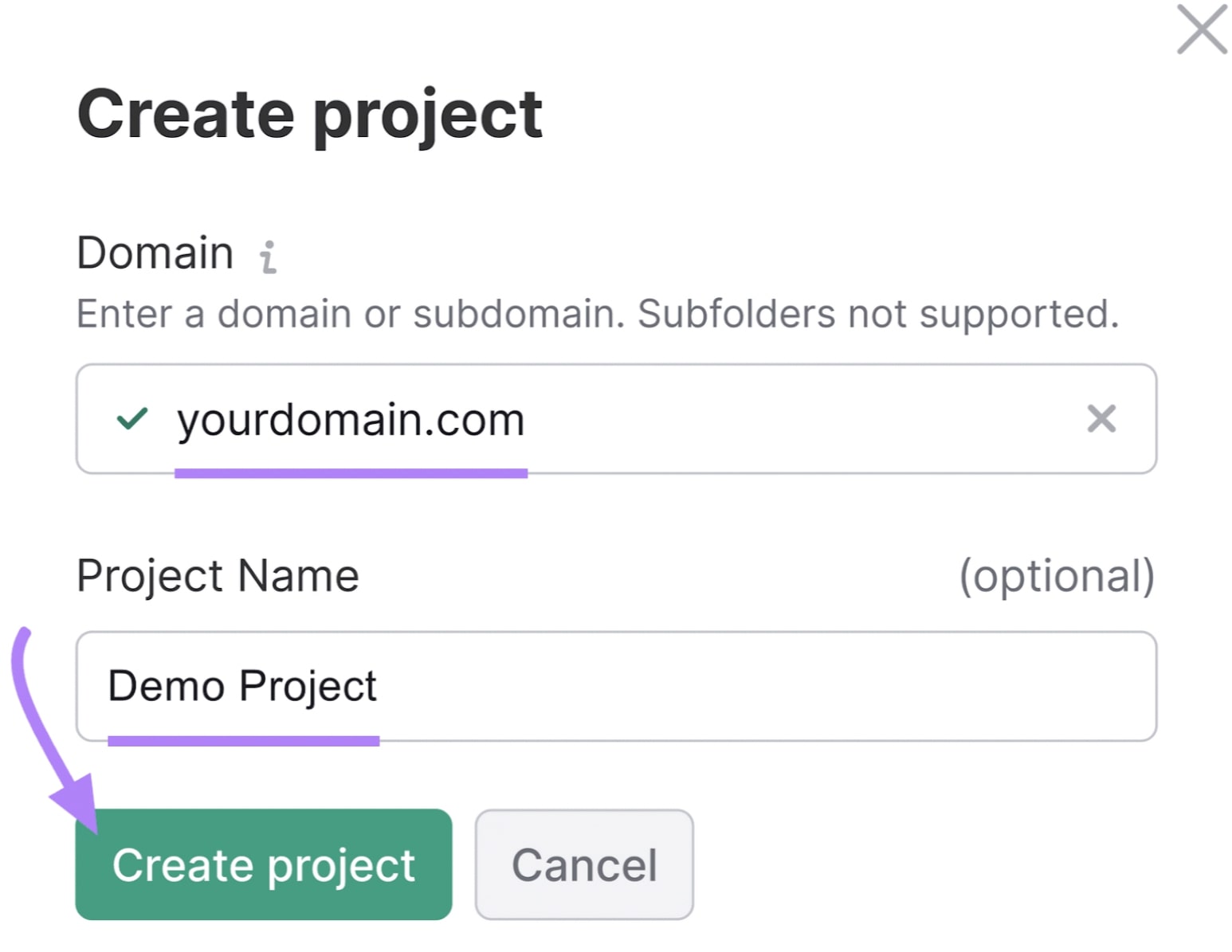
Next, click “Social Poster” under “Social Dashboard” from the left-side menu to open the content calendar.
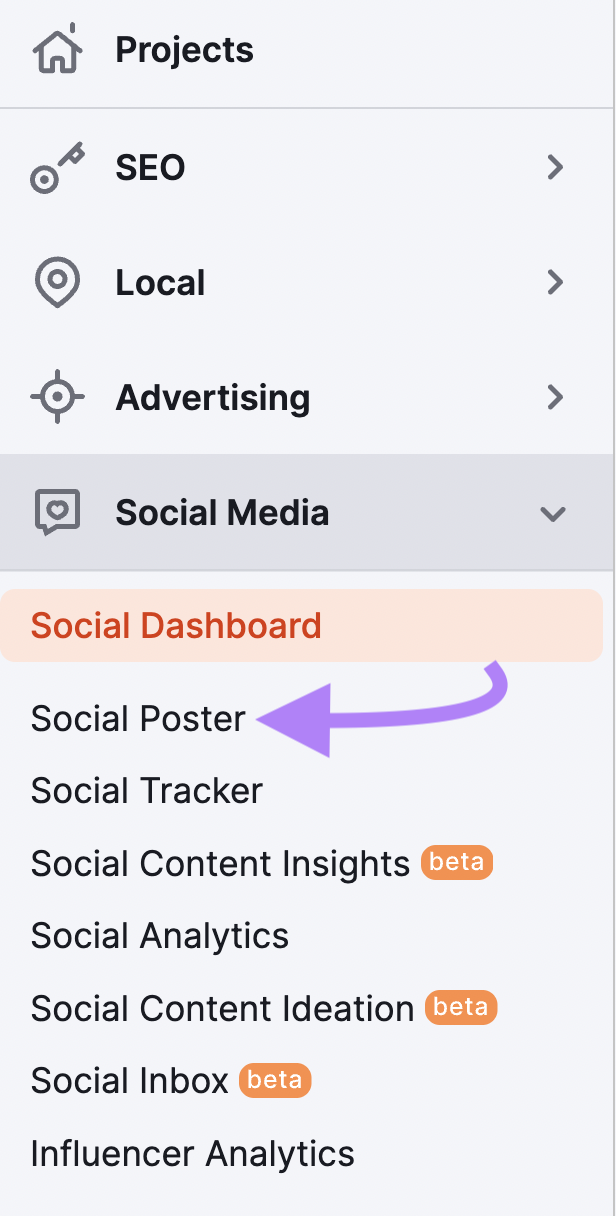
A pop-up will appear on an empty calendar for you to connect your social profile. Click “Add Profile.”
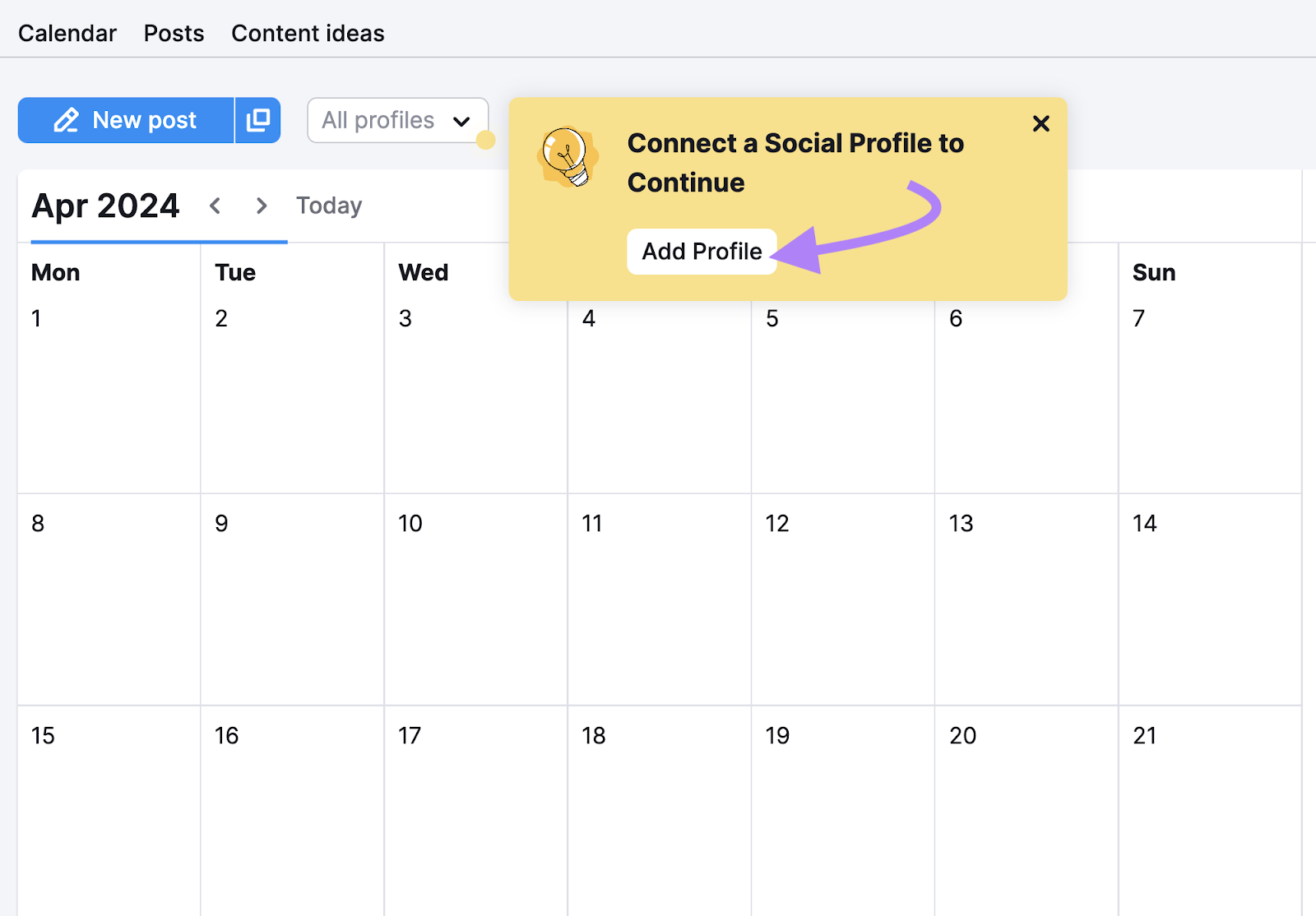
Select “LinkedIn” to link your profile to the calendar.
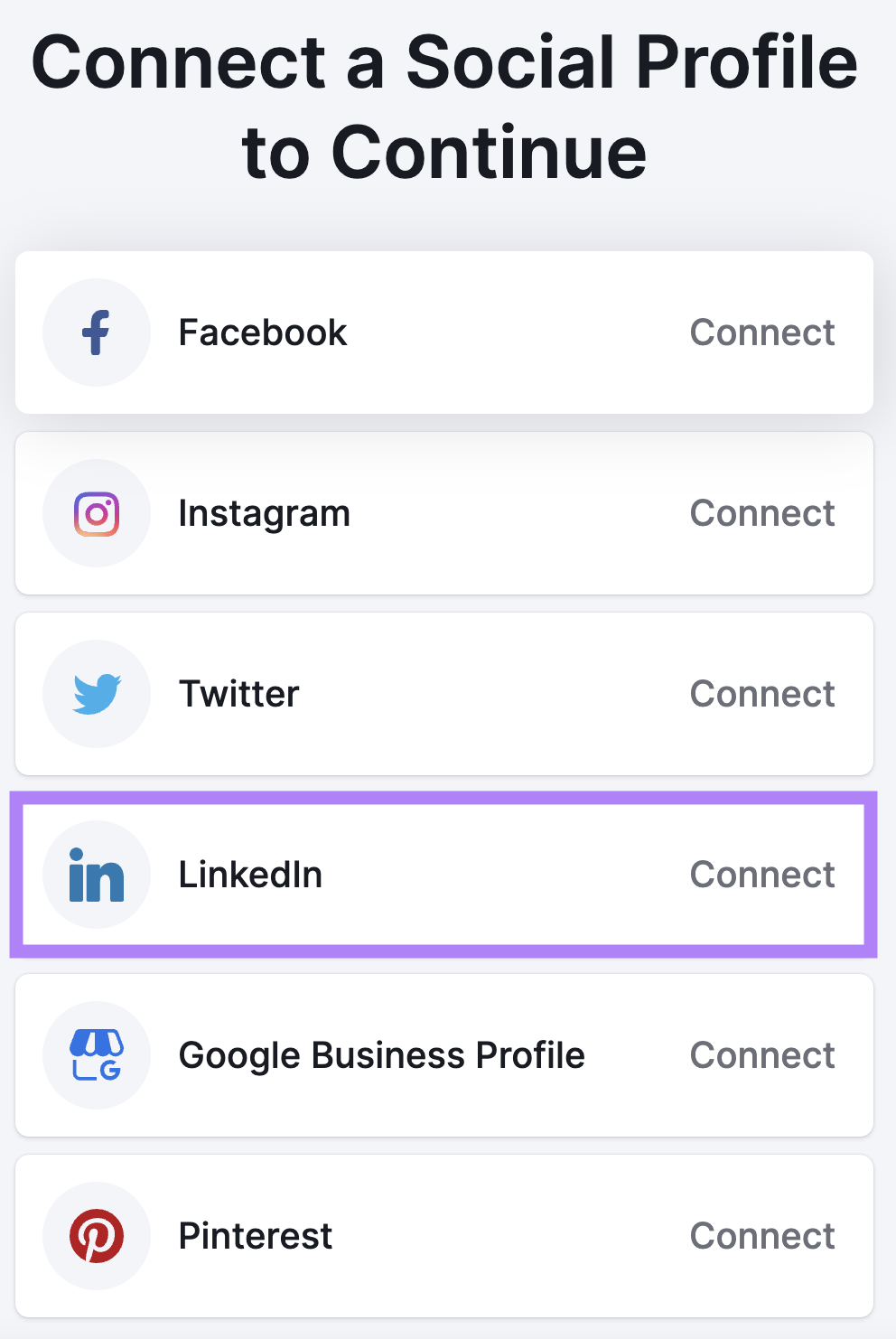
Tick the box next to the profile(s) or business name you want to post from. Click “Add profiles” to complete the setup.
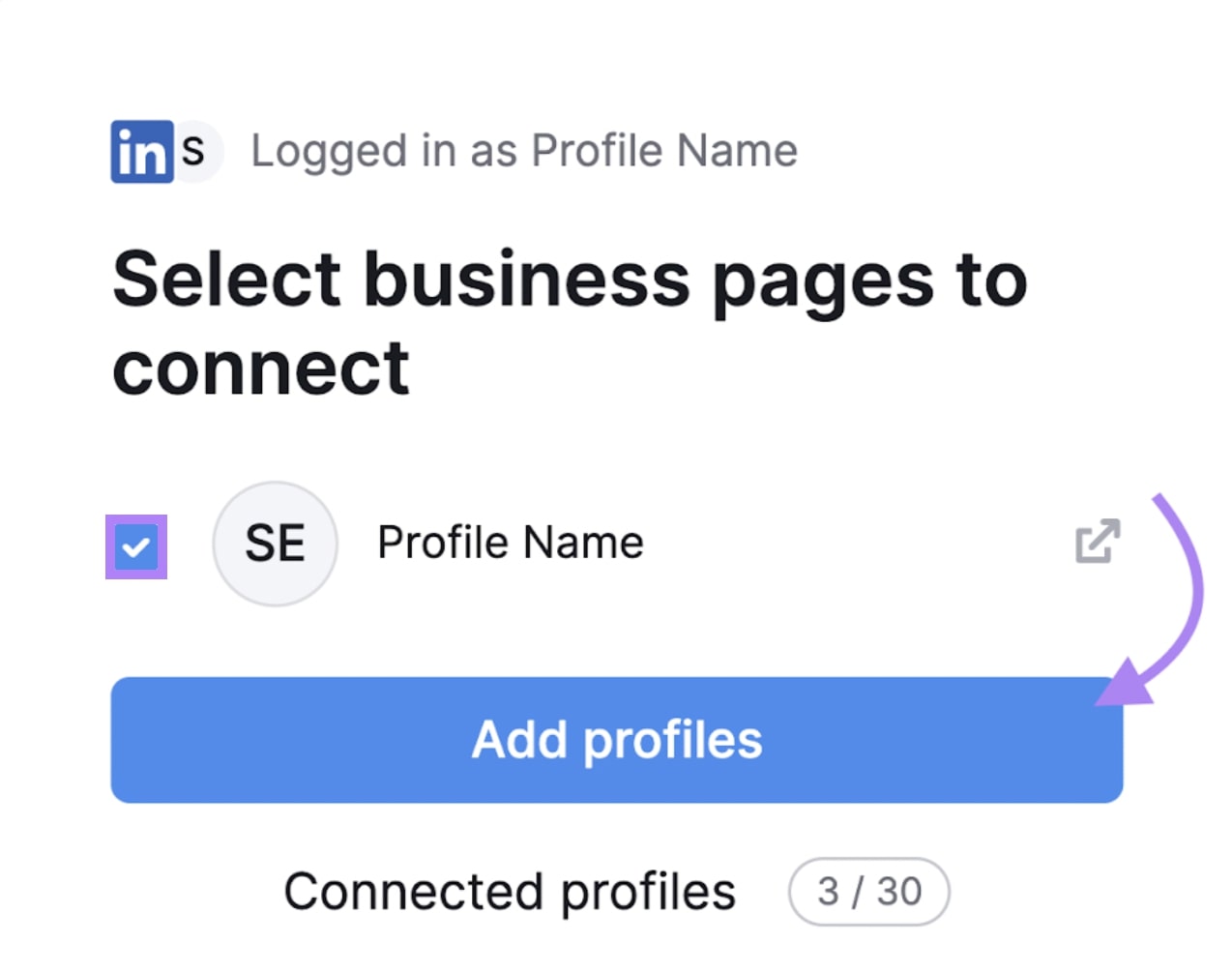
You’re now ready to create, schedule, and publish posts to LinkedIn from the Social Poster tool.
5. Engage with Your Audience
Regularly interact with your LinkedIn audience to nurture connections, establish credibility, and keep your name and business prominent among potential customers. Here are a few tips to achieve that:
- Acknowledge comments on your posts. Respond to people’s questions or thoughts to show that you value their input—it can help you build a genuine relationship with them.
- Comment on your connections’ posts to maintain a voice. Ask questions to encourage conversation. And share your expertise on topics relevant to your industry.
- Share industry insights, tips, and success stories in your posts to attract attention. Also, pose questions to your audience to encourage engagement. You’ll potentially spark discussions that could turn into a private conversation about how you can help.
Use Social Inbox to monitor and reply to LinkedIn comments and messages in an organized, efficient manner.
If you’ve already created a project in the Social Media toolkit and connected your LinkedIn account to it, go straight to the Social Inbox dashboard.
From here, you’ll be able to manage all comments, direct messages, and mentions.
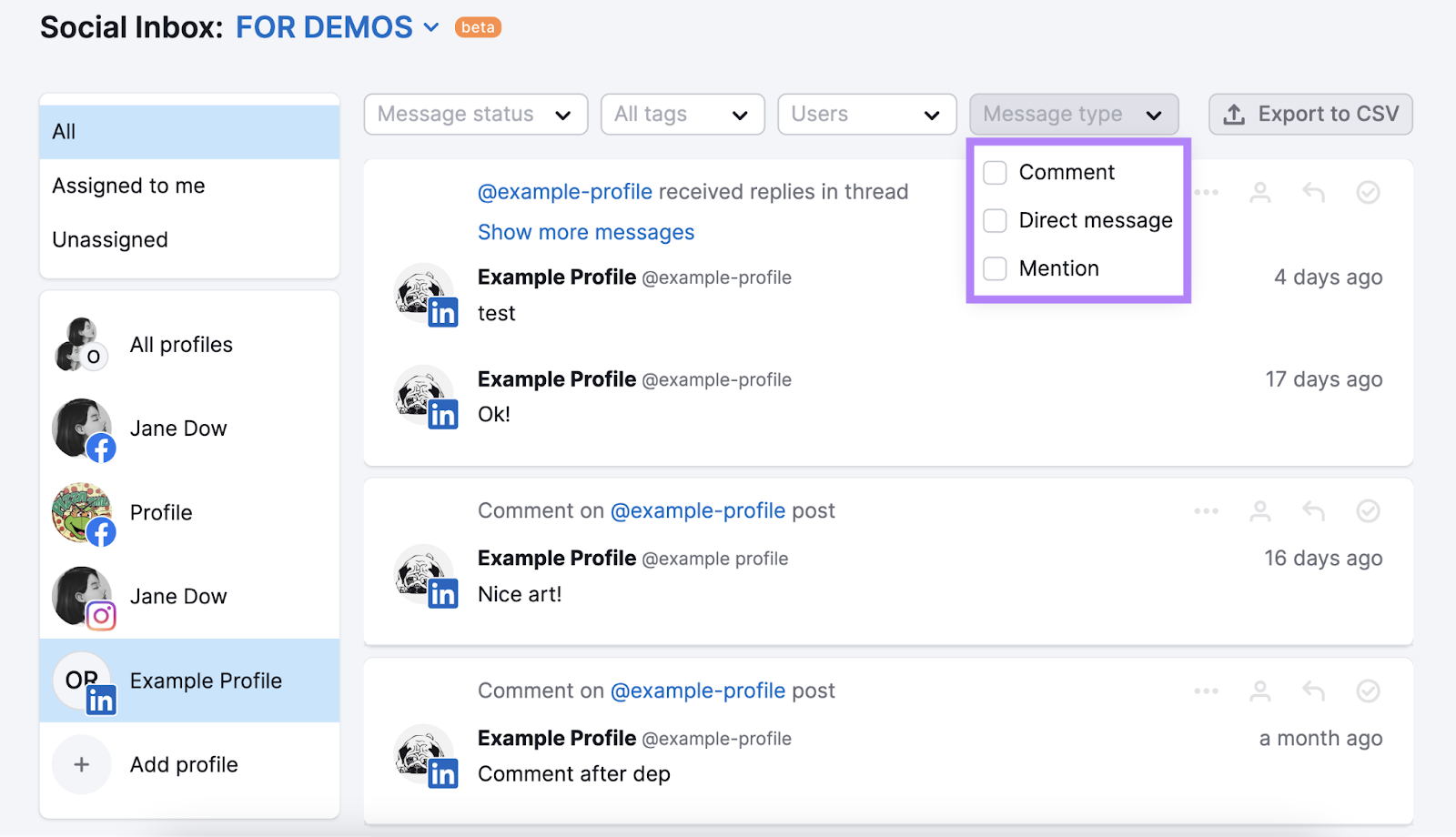
6. Join Relevant LinkedIn Groups
Use your personal profile to join LinkedIn Groups and connect with a targeted audience of professionals interested in specific topics or industries.
You’ll be able to:
- Identify networking opportunities with the right potential leads
- Actively participate in discussions to establish relevant engagement
- Share valuable insights to position yourself as an expert in your field
Going back to our tax prep business scenario, let’s say you join a finance group on LinkedIn. Members who may be looking for the services you offer will likely reach out to you based on your contributions to the group.
Examples of groups you could join to find leads include:
- Professionals in your industry or niche
- Small business owners
- Professionals in related industries or fields
- Business networking specific to your region
LinkedIn also lets you search for relevant groups by name or keyword—just follow the steps in its helpful guide.
7. Use LinkedIn Lead Generation Ads
LinkedIn has four different ad types you can set up to reach and convert your target audience. Some require you to create a free business page, while you can use your personal LinkedIn profile for others. We’ll explain what you’ll need for each type.
Use LinkedIn Sponsored Content to create posts intended to reach more people beyond your connections.
For instance, share thought leadership insights or promote your services. You’ll need to create a business page to post from if you don’t have one already.
Here’s a Mastercard sponsored post as an example:
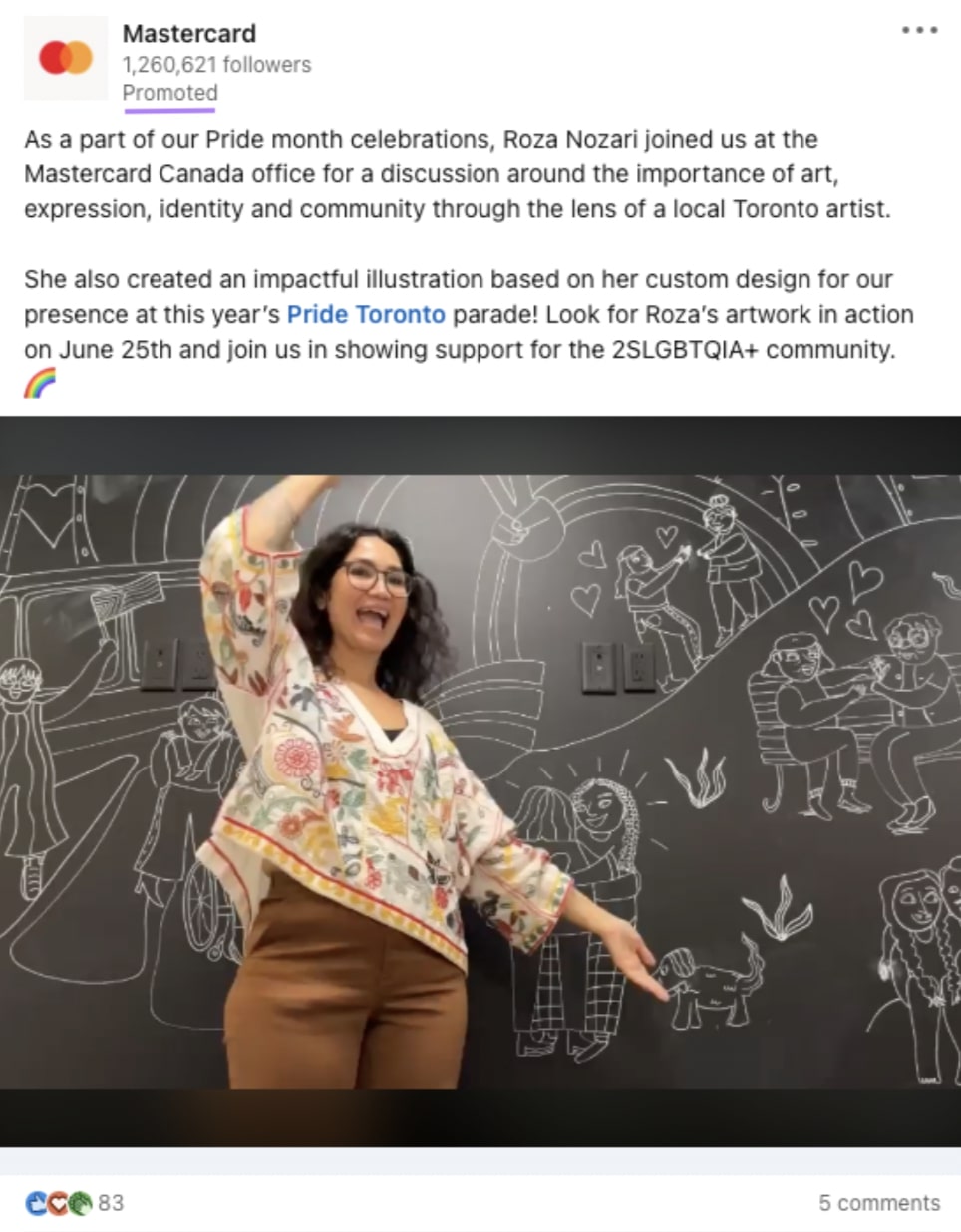
LinkedIn Sponsored Messaging lets you send private, personalized messages directly to your audience’s inbox—a much more efficient way to generate leads than contacting one prospect at a time.
Here’s an example of LinkedIn message ad:
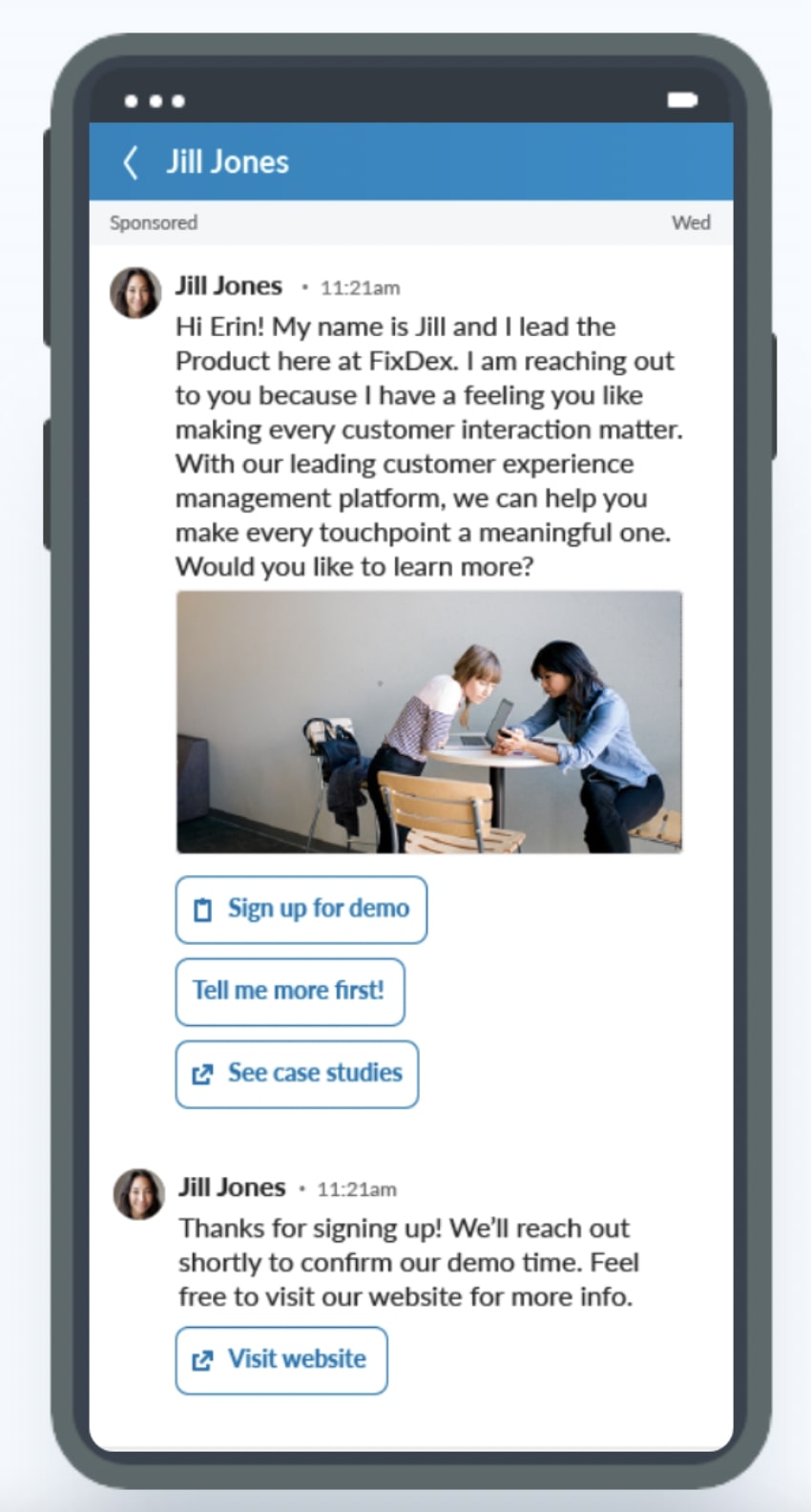
Use either your business page or your personal profile to set up sponsored messages. Ideas include offering some background about your offerings, a free trial, or a registration link to a live webinar you’re hosting.
Dynamic Ads
LinkedIn’s Dynamic Ads are automatically personalized to the consumer. You need to use your business page to set up this ad type.
Ads appear to the right of the platform’s desktop view and include the recipient’s first name and profile image—which draws their attention. They also include your brand’s logo.
Below is a Dynamic Ad that appears to a targeted user, Seth, with their name and photo. The advertiser, Startup Different, encourages Seth to follow the brand.

As with Sponsored Messaging, use this ad type to generate leads by featuring your service, promoting a free trial, or sharing an event registration link.
Text Ads
LinkedIn Text Ads are basic pay-per-click (PPC) or cost-per-impression (CPM) ads that allow you to choose your desired audience.
Either use your business page or your personal profile to set up these ads. Filter your targets by demographics and other criteria like:
- Job title
- Industry
- Geography
- Age
- Gender
- School
- Skills
- Company name
- Company size
- Membership in specific LinkedIn groups
The LinkedIn site displays Text Ads to the right, like Dynamic Ads.
Ads include a headline, a description, and an image (such as your brand logo). They also indicate to the user whether any of their connections follow you.
Below are two stacked Text Ad examples. Where simple, clickable headlines take the user directly to the respective landing page.
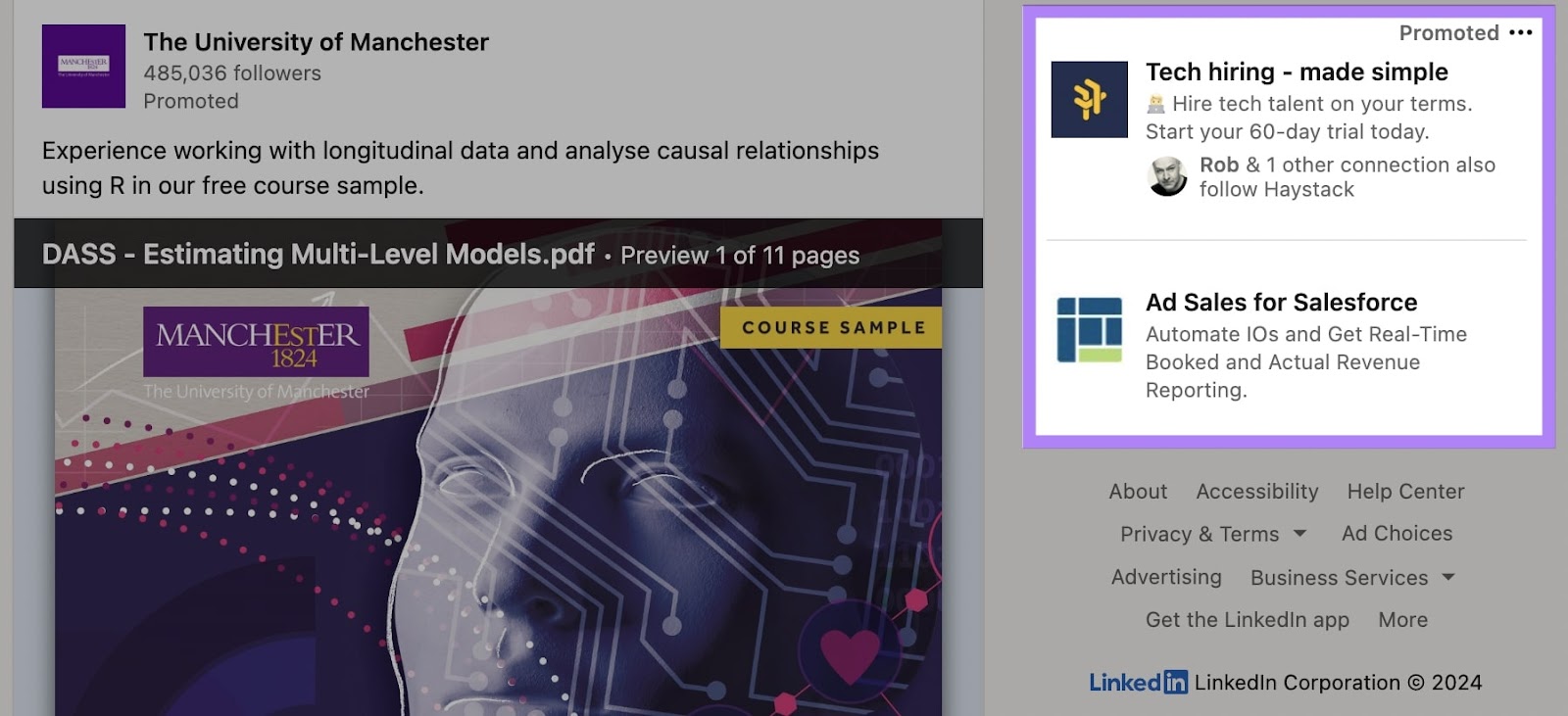
Follow LinkedIn’s step-by-step instructions to create your first ad campaign. And set up the Conversion Tracking feature to monitor performance directly in the platform.
Monitor Your LinkedIn Performance
Once you’re sharing content and growing your connections, you’ll want to see which posts get the best engagement, how big your LinkedIn reach is, new followers, and more. This way, you learn what’s most effective for generating leads. So you can do more of it.
Use Semrush’s Social Analytics tool to manage all your LinkedIn business page analytics from one place.
If you’ve already created a project in Social Media Toolkit and connected your LinkedIn page, go straight to the Analytics dashboard.
Click the “LinkedIn” tab.This is where you’ll explore “Audience,” “Engagement,” and “Posts” data such as audience reach and growth, engagement rate, and follower insights.
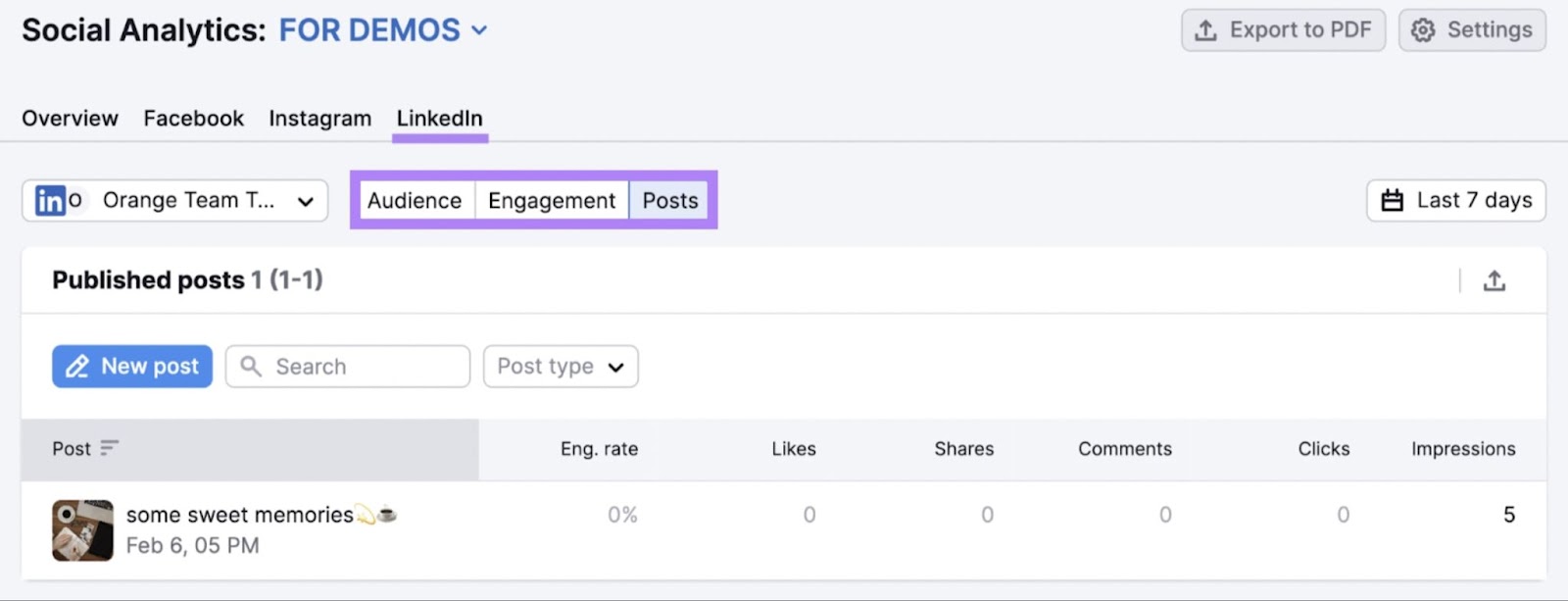
To change the time frame of your LinkedIn data, click the “Last 7 days” button. And choose how far back in time you want to analyze.
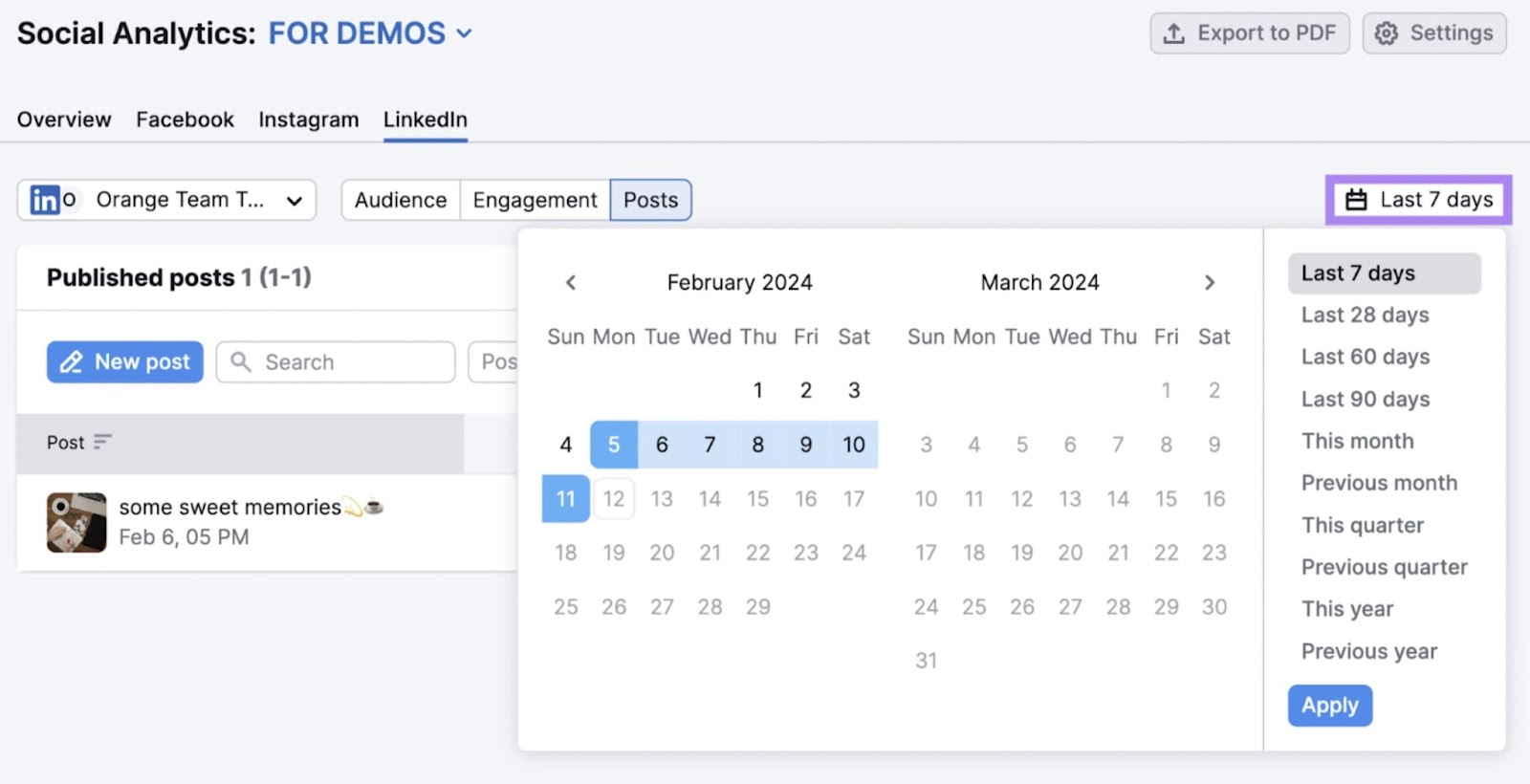
Semrush’s Social Content Insights complements Social Analytics to help you monitor your LinkedIn posts’ performance more closely. On both your personal profile and your business page.
The detailed dashboard shows key post metrics like reactions, comments, and shares.
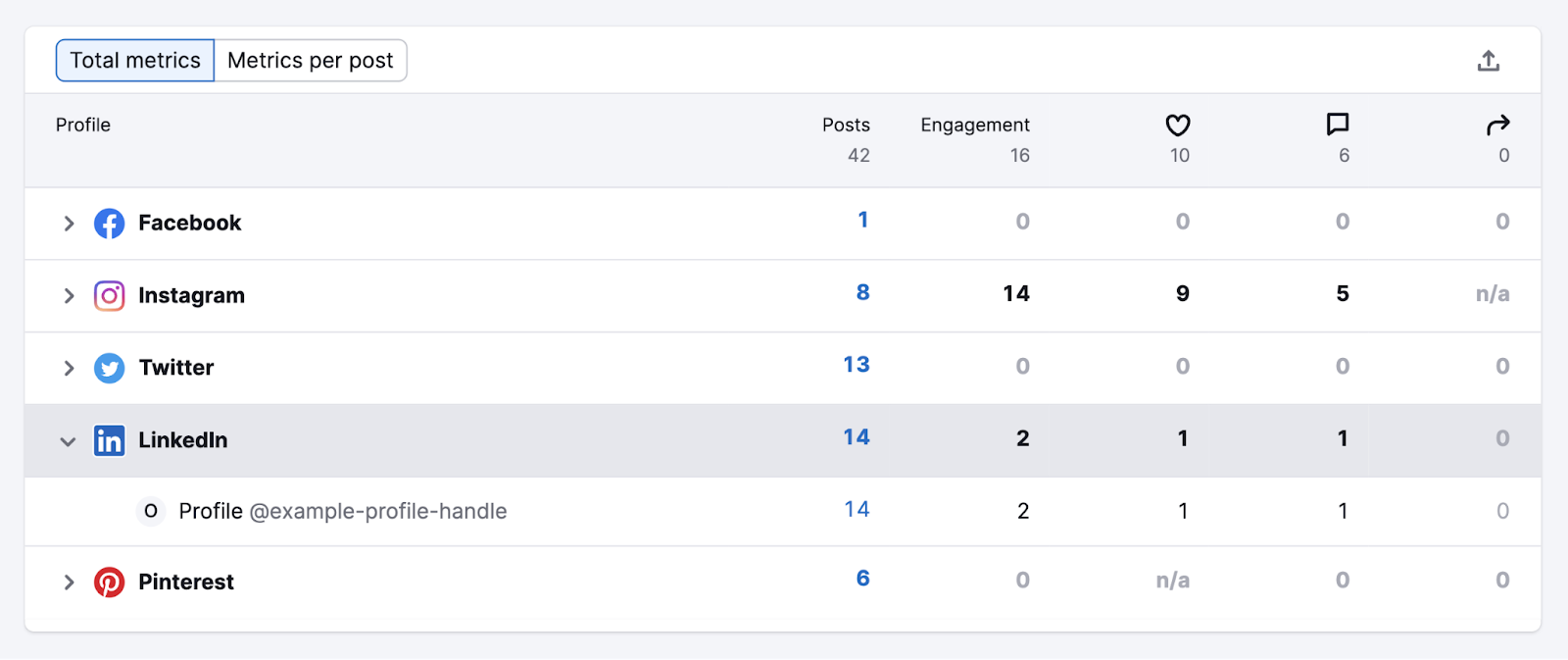
Dig into the individual posts’ numbers for granular insights into audience engagement levels. And what content resonates with your LinkedIn followers the most.
Let’s resume our tax preparer example. To consider scenarios where tracking your LinkedIn performance can help you fine-tune your lead generation strategy:
- By exploring historical data, you discover that January has the highest post engagement. Plan to post and connect more frequently at the same time next year.
- There’s an influx of new followers each time you share a collaboration post. Publish more of those for better results.
- You observe that links to customer success stories generate the most leads. Create additional similar content on your website and share it on your LinkedIn profile.
Capture More LinkedIn Leads with Semrush
As you grow engagement with your audience, pick a tool that could help you streamline, measure, and refine your LinkedIn lead generation efforts effectively. So you can focus on boosting conversions.
Semrush’s Social Media toolkit makes managing all of that easy. Start a free trial to draft and schedule your LinkedIn posts, analyze key social content stats, gain audience engagement insights, and more.
Source link : Semrush.com
